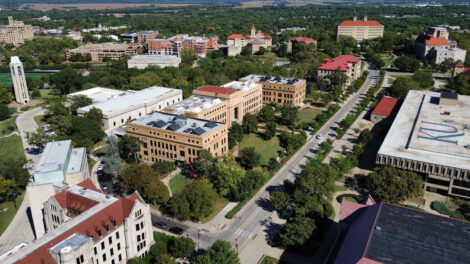Regents to consider KU’s plan to raise housing and dining prices; tuition decision will come in spring

photo by: Kim Callahan/Journal-World
The University of Kansas campus, pictured in September 2021.
The University of Kansas is seeking state approval to raise housing and dining prices by about 2.5% next year, and expects to determine whether to seek a tuition increase in March.
The Kansas Board of Regents next week will consider approving a plan that would increase the basic housing and dining plan at KU by about $230 a year, or 2.4%. KU also is seeking approval for about a 3% increase for its newer dormitories and its unlimited meal plan. That increase would add $393 in expenses for students next year.
KU’s two large in-state competitors — Kansas State and Wichita State — are not proposing increases to their housing or dining plans, but KU’s chief financial officer said increases at KU were needed to keep up with growing maintenance issues.
“Nobody likes to raise anything, but you can’t let your buildings fall apart,” Jeff DeWitt, KU CFO, told the Journal-World.
KU’s housing department operated at a $2.7 million loss last year, and only “critical” maintenance tasks were done on university housing facilities, KU told the Regents via a report.
On meal plans, DeWitt said prices needed to increase after three years of no increases and because the university is experiencing sharply increased prices for food. Last month, he said food prices were up 16.8%. KU has had to use about $1.5 million of federal funds to keep the dining service solvent during the pandemic, DeWitt said.
DeWitt said the proposed increases did come at a challenging time as the university is trying to grow enrollment to close a budget gap that will require cuts in 2024, if the university doesn’t generate new revenue. An increase in dining and housing fees will increase revenue, but only if the higher prices don’t drive students or potential students away from the university. DeWitt said KU leaders thought KU would remain competitive with other universities after the increases.
“We get that we have to keep college affordable, and we have to be able to recruit,” he said.
In terms of how KU compares with other Regents schools, the new rates wouldn’t change KU’s position. It would continue to have the highest or second-highest rates, depending on what category is measured.
Here’s a look at the proposed annual rates for each school’s “modest” housing option and limited dining plan:
• Wichita State: $11,110, up 0%
• KU: $9,930, up 2.4%
• Emporia State: $9,488, up 2.6%
• Kansas State: $9,480, up 0%
• Fort Hays State: $8,284, up 1%
• Pittsburg State: $8,180, up 2.8%
Here’s a look at annual rates for recently renovated or new housing facilities and unlimited dining plans:
• KU: $13,418, up 3%
• Wichita State: $12,660, up 0%
• Kansas State: $12,450, up 0%
• Emporia State: $10,188, up 2.4%
• Pittsburg State: $9,426, up 2.5%
• Fort Hays State: $8,803, up 1%
The bigger financial decisions for KU and the Regents may involve whether to raise tuition prices. KU has not raised tuition for the last three years, DeWitt said. Tuition proposals are not due to the Regents until May. DeWitt said he expected the university would have a better idea in March whether it needed to propose a tuition increase.
“In March, we’ll have a better feel for how the budget is coming in and how recruitment is going,” DeWitt said.
As usual, he said the Kansas Legislature’s decision on how much funding to provide higher education also would play a role in the tuition calculations. KU, however, would have to receive approval from the Board of Regents to implement any tuition increase.
Other items in KU’s report to the Regents include:
• KU has 4,699 people living in student housing this year. That’s up from 4,015 last year, but down from a recent high of 4,923 in 2020.
• KU’s housing revenue is estimated to be $34.8 million this school year, up from $27.7 million last year, but down from $34.6 million in 2019 before the pandemic disrupted operations.
• With the rate increases, KU expects to collect about $37.8 million in housing revenue next school year. After spending about $2.4 million on repairs and other capital expenses, total housing revenues are expected to be about $5,300 more than expenses next year. Despite the recent downturn, KU’s housing operations have continued to pay down debt. Debt totals in 2022 will be about $67 million, down from about $80 million in 2020.
• KU is projecting its occupancy rates in student housing to be 95% next year, down from about 97% this school year. KU’s occupancy rates generally are higher than other Regents schools, according to the reports provided to the Regents. Kansas State has the lowest occupancy rates at about 65%, while Emporia State’s rate has been 85%, and all other Regents schools are at 90% or above.
The Regents meet Wednesday in Topeka.







COMMENTS